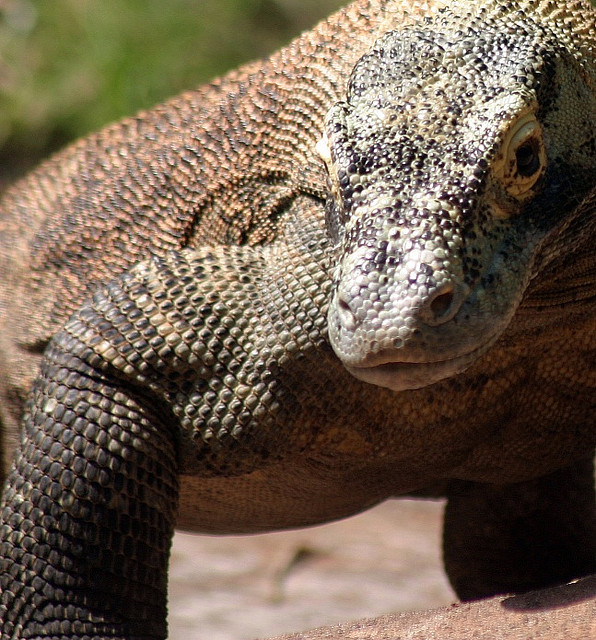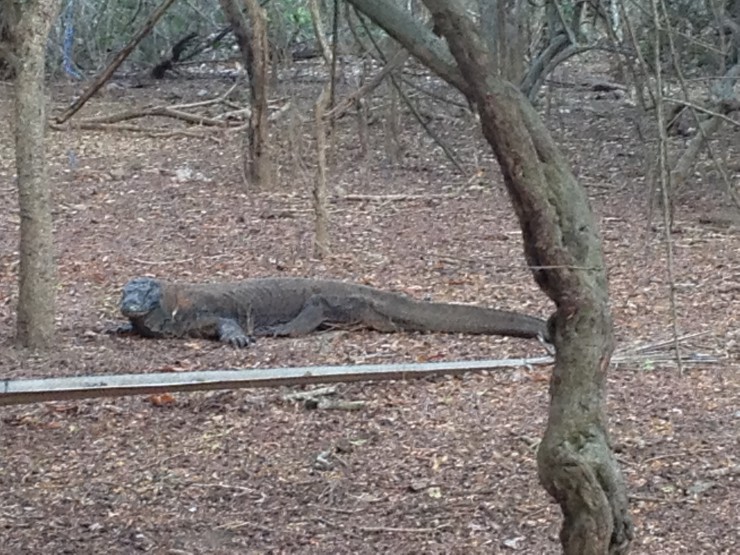During my more rugged travel experiences, I have often found myself confronted with the formidable task of facing the limitations and boundaries of my physical self. While in India, for example, I often had to contemplate the dilemmas of drinking water (and therefore needing to pee in places where “clean restrooms” did not exist) or becoming dehydrated. (This problem kills malnourished children in developing countries while it merely poses an embarrassing inconvenience for those with generally good health.) On another trip, I had become ill and had vomited violently for two days, leaving my body empty of calories and unable to climb up a sizeable hill to see a grand historical fort. Halfway up that hill, my normally spunky and determined self had a revelation about my newly reimagined relationship between food and energy.
On a trip to Indonesia, I had the opportunity to visit Komodo Island, home to the infamous Komodo dragons. My six-year-old nephew informed me (gleefully) that these creatures are extremely dangerous and kill people and animals by biting them, allowing multitudes of mouth bacteria to infect the body, and watching them slowly die. The dragons can then follow around the dying animal and consume their corpses them once their prey is left defenseless and paralyzed with bacterial infection. Before arriving on the island, our guide told us similar stories about the dangers of the Komodo dragon: There is no “anti-venom” equivalent for Komodo dragons and, as such, people die every year by accidentally trekking alone or mistaking Komodo for another Indonesian island. The death of unsuspecting tourists happened often enough that park rangers must now escort guests on the island as a mandatory safety measure. Precautions of every sort must be taken.
Just prior to arrival, excited for the chance to see Komodo dragons in their natural habitat, I received a notice in my room saying that menstruating women could not step foot on the island of Komodo and that only non-menstruating women could enter the island. The notice also informed visitors that people with wounds could not visit the island (though it did not specify the type and size of wound it was referring to), and visitors could not wear any red coloring on their clothing or backpacks. Komodo dragons have a particular combination of aggression, keen smell, bad eyesight, and bloodlust.
As a critical feminist, I initially refused to believe the reality of the caution against menstruating women, imagining that it must be yet another method of excluding women from “men’s” activities like trekking, hiking, and exploring the island. Did these cautions simply represent a repackaging of the “menstrual hut” idea? Would menstruating women actually inspire attacks? Did menstrual blood have a particular “scent” that differentiated it from other kinds of blood? What about women who lived on Komodo Island? How could resident Komodo women protect themselves? Was the ban yet another sexist maneuver to control women and their bodies? Inquiring about this “menstrual ban”, I learned that the dragons can smell blood for up to five miles, and, lacking the ability to discern their “dying” prey from menstruating women, could mistake menstruating women for dying animals and kill them. A series of attacks on menstruating women have been documented on the island, leading the rangers to warn menstruating women that they must not come near Komodo dragons under any circumstance.
My next thoughts focused on the actual disclosure of women’s menstrual status. Typically, few strangers in the U.S. feel entitled to ask women about menstrual status. Would the park rangers actually ask women about their menstrual status? Could a menstruating woman who lied about her status put the group at risk? When I started inquiring about this further, I found that discussions about Komodo Island presented one of the only contexts I can remember when menstrual status could be discussed across genders, ages, races, and cultures, as the notice of warning inspired the group to discuss menstruation openly in ways I had never personally witnessed before. Over dinner the night before our arrival in Komodo, the group I was traveling with discussed menstruation critically, frankly, and in unusual detail. Even though the discourse included (somewhat traditional) notions of “protecting women”, it also provoked the group to consider some of the questions I had asked about the cultural and gendered aspects of menstrual disclosure. Getting “comfortable” with the topic was not an option for women young enough to menstruate, as they had to openly disclose their status regardless of whether they would prefer to keep it secret. Never before had any of us confronted the idea of “security personnel” who would confirm whether we were currently menstruating (a subject that provoked more serious consideration of TSA intrusions on people’s personal lives as well).

Photo by Scott Ellis // Creative Commons NC-SA 2.0
Once on the island, walking among the trees and dusty landscape behind our ranger who carried only a large stick with a forked end, my childlike glee at the Indiana Jones-like qualities of the adventure superseded my fear of Komodo dragon attack. When we finally found the dragons, lazing about in clusters near a spot in the late afternoon shade, I felt a twinge of gratitude that my body had decided not to bleed that day. In my “normal” life, battling the stereotypes and secrecy that surround menstruation, confronting the shame and silence women face about their menstrual cycles, this newfound idea of menstruation as a kind of animal communication felt like a welcome diversion. Menstruation as danger, as physical threat, as something that could put oneself or one’s travel mates in jeopardy seemed unusually exotic, bizarre, and informative. Even more interestingly, the ability to discuss menstruation so openly with such a unique mix of people, under such strange circumstances, provided the opportunity to attach menstrual status to adventure and to remind myself that the narratives we as Americans have about menstruation do not yet reach around the globe.



Great story! Very interesting way of linking the precautions with social practice and taboos. Thanks for posting it.
So interesting, thanks for sharing
,